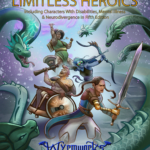Disproportionate Growth

1d4 areas of your body are (IE) × 20 percent smaller than their typical proportion for your ancestry. Choose or roll on the following table. This smaller stature allows you to hide more easily, giving you a +(IE) bonus on Dexterity (Stealth) checks.
| d20 | Shortened Area |
|---|---|
| 1–4 | Trunk |
| 5–7 | Arms & Hands |
| 8–10 | Legs & Feet |
| 11–13 | Arms |
| 14–16 | Legs |
| 17–20 | Head |
- Trunk. Because most of your internal organs are in your trunk, some are underdeveloped, causing a −(IE) penalty on Constitution saving throws.
- Arms & Hands. You can’t use 2-handed weapons effectively. Because you have less leverage, you have a −(IE) penalty on contested Strength checks.
- Legs & Feet. Your movement speed is reduced by (IE) × 5 feet. You also have a −(IE) penalty on Dexterity checks to balance.
- Arms. Your arms are shorter, but your hands are average size. Because you have less leverage, you have a −(IE) penalty on contested Strength checks.
- Legs. Your legs are shorter, but your feet are average size. Your movement speed is reduced by (IE) × 5 feet.
- Head. The reduced size of your head causes (IE) other traits according to the following table, each with its own IE.
d6 Trait 1 Seizures 2 Intellectual Disability 3 −(IE) on Dexterity checks to balance 4 Swallowing Difficulties 5 Hearing Loss 6 Refractory Issues
Real-world Examples
Achondroplasia, Turner Syndrome, Growth Hormone Deficiency, Spondyloepiphyseal Dysplasia Congenita, Microcephaly
Assistive Options
Wheelchairs and other mobility devices can be helpful to assist with some of the penalties associated with these traits.
Magical Assistance
Magic items that give magical strength such as a Girdle of Giant Strength can assist with the Strength penalties of some of these.